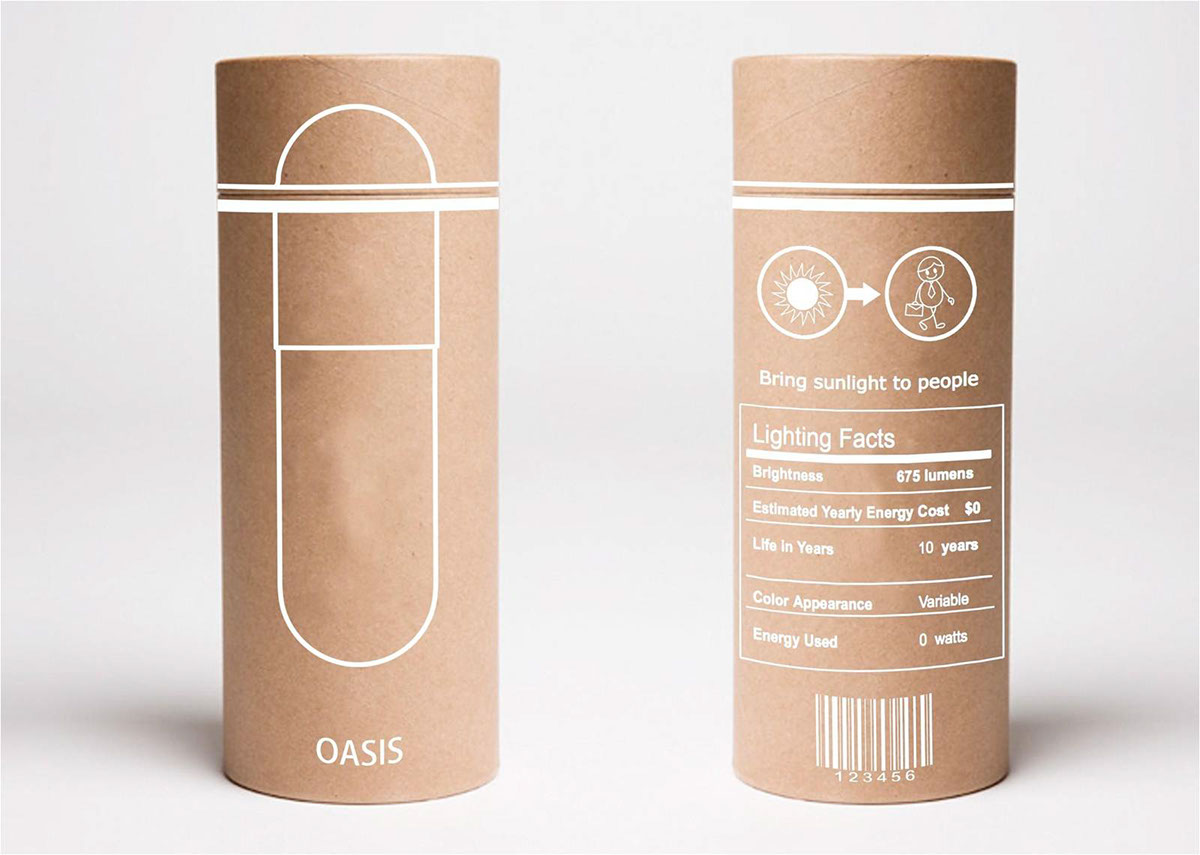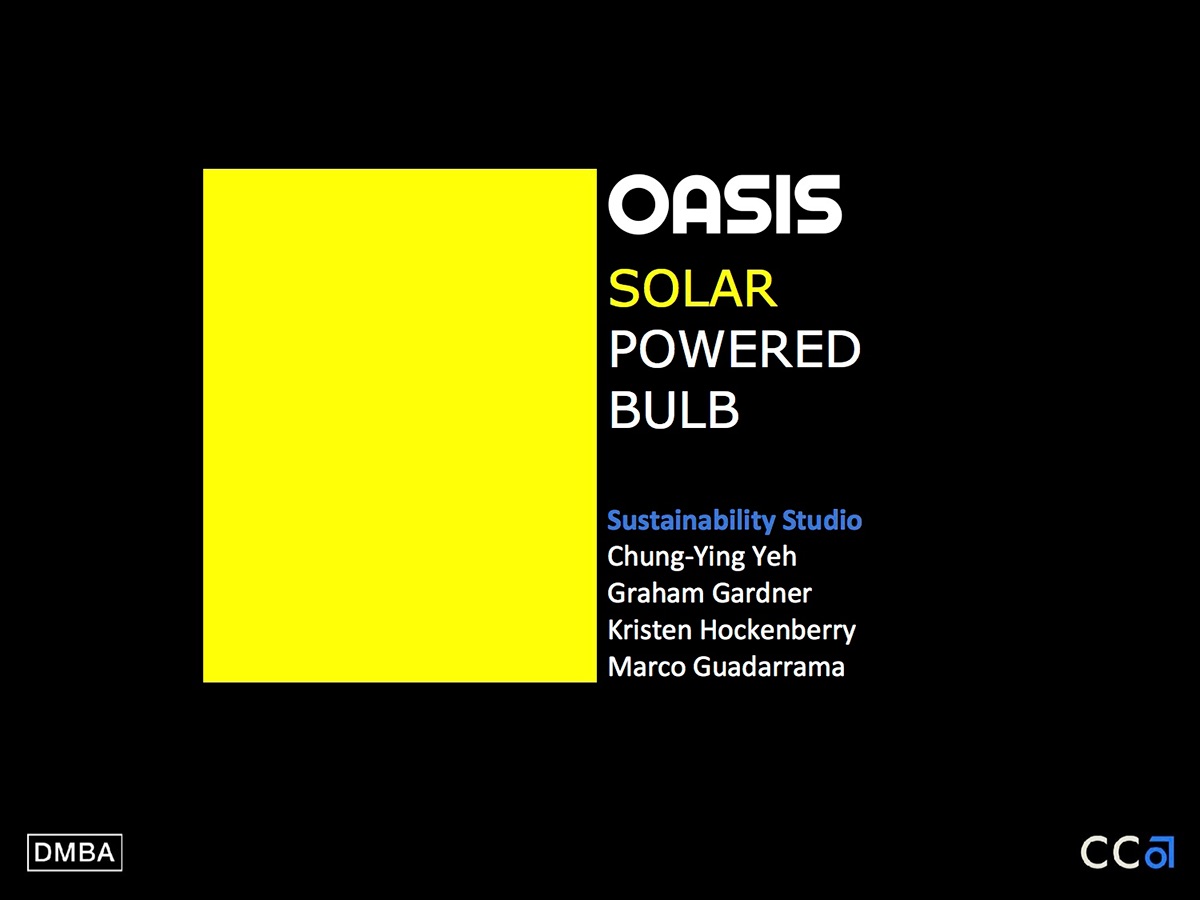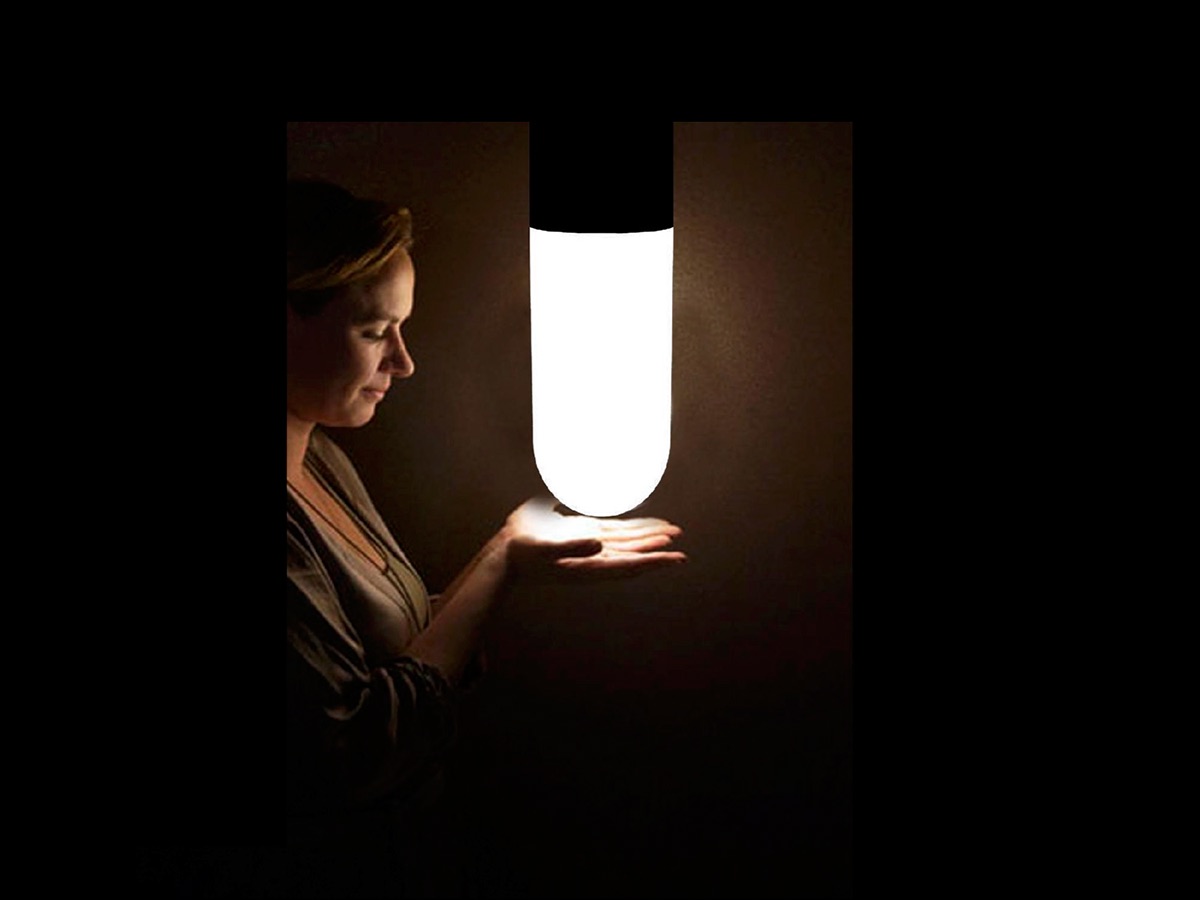
Traditional American office design is broken. Workers are unhappy and productivity suffers. Our research into workplace lighting led us to explore the question: How might we make office lighting more sustainable and office environments more enjoyable by offering lighting alternatives and changing energy use behaviors? The answer is increased natural light. Based on our research, workers seek more natural light because it provides warmth, energy and improved mood. Office managers, landlords and companies benefit from reduced electricity costs. And society benefits from reduced greenhouse gas emissions, lower pollution levels and increased worker productivity.





Sustainability Challenge
Artificial lighting illuminates most workplaces yet workers are dissatisfied with the lack of natural light available in traditional offices. Poor lighting design has real implications for worker health and environmental sustainability. According to the Tennessee Valley Authority, 35% of all workplace energy consumption in the United States is related to lighting[1]. The International Dark-Sky Association reports that one-third of this energy use for lighting is wasted, resulting in 14.1 million tons of CO2 emissions each year in the US[2]. An audit of California office spaces found that 40-60% of office lighting is wasted or unnecessary[3], suggesting that the International Dark-Sky Association figures could be low. Much of the effort to improve lighting efficiency in office environments has been focused on creating lighting technology that is more efficient and user-friendly. While these efforts are necessary, there appears to be a gap in the market for affordable daylighting solutions. According to our research, workers seek better natural light access, not necessarily more efficient lighting. In a study of US office workers by Logitech, only 6% of respondents gave their workplace an ‘A’ rating for environment.[4] Steelcase researchers found that 86% of workers said increased natural light access would reduce eyestrain and headaches.[5]
Stakeholder Analysis and Concept Development
Our group explored the issue of sustainable lighting in work environments by identifying key stakeholders, surveying workers, conducting secondary research, and engaging in ethnographic studies. Over 100 workers were surveyed in an initial study into lighting in the workspace. Coupled with secondary research and observational studies, the survey helped us to arrive at key insights about lighting in the work environment:
● Workers desire more natural light
● Workers desire more control over lighting sources
● Information is lacking about energy use and the environmental effects of office work
● Workers desire a more enjoyable work environment
Based on these insights, we sought to design a solution to make office environments more sustainable and environmentally friendly by offering lighting alternatives that increased natural light access and reduced energy consumption.
The first iteration of the OASIS concept was an architectural design for an energy and water-neutral, naturally lit, whimsical, and modern shared office space to be located on unused land, parks or on top of buildings in dense urban centers. However, we encountered a number of challenges with our initial concept that made it unfeasible: cost-prohibitive, not space efficient, and difficult to scale.
As our project progressed we pivoted to explore the idea of bringing better natural light into existing office environments. While large office buildings require high-tech, expensive and/or bulky solutions to increase natural lighting and reduce electricity use, we found a category of work spaces ripe for innovation: modular offices, schools and warehouses. We estimate that around 4 million Americans work in modular offices and/or warehouses.[6] With thin roofs, simple constructions that are typically single story (our concept does not target two or three story modular spaces), and poor lighting, these spaces are in need of innovations that bring natural light to workers cost-effectively, sustainably, cheaply, and beautifully.
Product Description
OASIS is a ceiling-mounted solar bulb designed to be a low-cost and efficient solution for workers in modular office spaces. More energy efficient than typical artificial lighting sources and more light efficient than traditional skylights, the key to the OASIS is its special design, which uses water to intensify the light emitted into an enclosed space and to diffuse light as a light bulb would. OASIS creates access to more natural light during daytime hours - the typical working time for most American workers - which contributes to improved health, more enjoyment and greater productivity.
OASIS was inspired by a social project born in the Philippines that uses used PET water and soda bottles to bring light into dark living and working spaces for impoverished Filipinos. OASIS iterates use of this simple but innovative concept by making a product that is bigger, more effective, and that can be manufactured and distributed at a lower cost using materials that are 100% recyclable and have a longer lifecycle than a PET bottle.
Composed of 4 main elements, the OASIS solar bulb’s shape its designed to be easy to manufacture and easy to install.
The figures above show the four parts of OASIS: 1) A solid molded acrylic dome that will sit above the roofline to capture and magnify sunlight; 2) a hollow molded acrylic tube that will be filled with 3L of water and ⅛ cup of bleach or hydrogen peroxide to maintain water clarity; 3) a rubber pad to sit between the dome and the roof to seal the hole and prevent leakage during rain; 4) an aluminum sheath that creates a clean look in the building’s interior while also acting as a reflective surface where the tube passes through the ceiling. The dimensions of OASIS are ideal for installation into a modular office, which is typically constructed with an 8-inch gap between the roof (corrugated metal) and a drop ceiling. The 7-inch diameter hole is comparable to recessed lighting and does not require extensive cutting to install, as opposed to a square or tubular skylight.
The components of OASIS are 100% recyclable and can be constructed of recycled materials if available. However, that is not to say that OASIS does not involve tradeoffs. OASIS will be manufactured of acrylic plastic, which has minimal but some harmful human health effects, according to a life cycle assessment (see below). The reliance on such materials, rather than reusing a product such as a PET bottle, makes OASIS inferior in some regards. The necessary addition of bleach (preferable) also introduces a toxic chemical into the OASIS system. However, overall the OASIS footprint is small and has a positive social impact, as will be seen in the sections below.
Product Comparison
OASIS solar bulbs provide access to natural light for modular office and warehouse workers and at a lower cost than artificial lighting. OASIS solar bulbs bring people natural light, which contributes to better worker health, more enjoyment and greater productivity compared to artificial lighting products. But the value of an OASIS solar bulb is much more than its cost effectiveness and worker happiness impact alone. OASIS also delivers superior environmental outcomes compared to artificial lighting products without diminished performance. The sections below outline our comparison between OASIS and a 12 watt Compact Fluorescent (CFL) bulb in terms of lighting performance, environmental impact, and cost.
Lighting Performance
Lighting brightness is measured in lumens, providing a standardized measurement to compare OASIS to an artificial lighting source. As the table below shows, the expected average light output for OASIS is comparable to the 12W CFL.
Category 12W CFL[1] OASIS
Brightness 625 Lumens 675 Lumens[2]
Lifespan (8hrs daily) 2.5 years 10 years
Energy Use 12 watts 0 watts
Environmental Impact
OASIS delivers superior performance in terms of environmental impact compared to the CFL bulb in two key areas: materials and greenhouse gas emissions. We conducted a life cycle assessment (LCA) of the 12W CFL and OASIS and found that OASIS overall is 99% more efficient, due to:
● Zero energy consumption
● Use of recycled and recyclable materials
● Lack of mercury (mercury vapor is used in CFL bulbs)
Though the carbon emissions of one CFL bulb are minimal, if the sales of OASIS were to meet expected demand, the impact over a ten year period (the lifespan of OASIS) on total greenhouse gas emissions would be more considerable. The replacement of 446,500 12W CFL bulbs powered by a standard mix of US energy sources (fossil fuels and renewables) would result in the reduction of 190,000 tons of CO2 over a 10 year period, the equivalent of removing 40,000 cars from the road.[3]
Consumer Cost
To remain competitive OASIS must be easily installed and cost effective in the short and long-run. The product itself is simple, easy to manufacture and is made of standard materials, which makes the cost of one OASIS comparable or even slightly cheaper than the retail price of a 12W CFL ($5 for OASIS compared to $4-10 for a CFL - for the sake of comparison we assumed a $6 CFL). However, OASIS must be installed onto and through a roof, which drives up the short-term cost considerably, cutting into the competitive advantage for OASIS on retail price.
Using a 1,000 square foot modular office space as a illustrative example, the table below outlines the expected consumer cost of artificially lighting a space for 8 hours per day versus using OASIS. If one bulb illuminates 25 square feet of space then 40 units would be needed to cover the 1,000 square foot office.
Category 12W CFL OASIS
Units Cost $1,000.00 $200.00
Installation $0.00 $600.00
Electricity $133.15 $0.00
Total $1,133.15 $800.00
The key factor for the OASIS cost to consumers is installation. We were not able to derive an exact figure for installation because OASIS is a unique design and there is not one standard size for modular offices. The $600 installation estimate is based on aggregated information from local (Bay Area) skylight installers. Using a tubular skylight as reference, we estimated $600 to be the cost of installing multiple lights in one location. Installing just one skylight can cost upwards of $1,000, but this is for houses with sloped roofs, well designed interior finishes, more costly materials (compared to corrugated metal on modular office buildings), and non-standard sizes. By comparison, OASIS can be installed using a router and materials and fasteners that come with each unit.
Business Model
We believe there is a viable business for OASIS in the United States. With over 4 million US workers located in warehouses or modular offices, which likely number in the tens of thousands, there would be a sufficient market to support the manufacture of OASIS. More cost effective than traditional skylights or common artificial lighting, and offering access natural light for dimly lit office spaces, OASIS has a strong value proposition to companies, managers, and modular office companies that seek to create a work environment that offers better health, more enjoyment and greater productivity.
Based on our research we estimate that there is more than 300,000,000 square feet of modular office and warehouse space in the US. A typical work space requires a light source to cover 25 square feet, which means the required number of light sources is around 12,000,000. If OASIS were to capture just 0.5% of that market in the first year and then grow rapidly over a five year period, we estimate that upwards of 450,000 would sell.
Financial Mode
Sales projections are based on the assumption of 0.5% first-year market share of the 12 million unit market for modular offices and warehouses. We estimated subsequent sales growth year-on-year of 20%, putting the number of units sold after 5 years at 446,500. OASIS would be sold direct to consumers at a price of $5 per unit, which would generate $2.23 million in revenues over five years.
The cost of OASIS is driven by materials, manufacturing and labor. On a per-unit basis the materials costs are $0.2 for recycled acrylic, $0.05 for recycled aluminum and $0.05 for rubber, based on information obtained from Chung-Ying’s uncle, who runs a plastics molding factory in Taiwan. Assuming an $8 per hour wage, the labor to produce OASIS would come to $0.2 per unit, for a total variable cost of $1.5 per unit produced. The mold to produce the acrylic would cost approximately $1,600.
Factoring in overheads, the profit and loss statement for 5 years would look as follows:
Per Unit Total
Sales $5.00 $2,232,500.00
COGS $1.50 $669,750.00
Gross Margin $3.50 $1,562,750.00
Overheads $1.50 $669,750.00
Donation $1.00 $446,500.00
Total $1.00 $446,000.00
Social Impact
The OASIS business model is a version of the “one-for-one” model popularized by consumer products such as Tom’s Shoes. For each OASIS sold, $1 will be donated to organizations in Southeast Asia that are helping urban poor communities to install PET bottle lamps. Based on our research[4] into the projects that fund the PET bottle lamp installations, it costs approximately $4.50 in materials and staff time to install bottle lamps in one household. Over a five year period the estimated $446,500 raised in donations would help these organizations to install lamps in nearly 100,000 homes. The zero-energy, 100% recycled PET bottle lamps bring cost-effective lighting to families and small business owners who live on the margins of society. Urban poor communities are often dark and so daylighting significantly improves the comfort and livelihoods of households with PET bottle lamps. With electricity costing as much as $0.45 per kWh in some Southeast Asian countries[5] a solar lamp brings real financial impact to households living on $2 or less per day. If a shop owner in a crowded market or a craftsperson working from home reduced their use of a 10W CFL bulb for 8 hours per day in Southeast Asia, at $0.45 per kWh the total annual savings would be $13.14, or about 2% of annual income at $2 per day.
The social enterprise model is designed to create a connection between American workers enjoying increased natural light and those in a developing country benefitting from a PET bottle lamp. Together, Americans and people in Southeast Asia will enjoy the benefits of increased natural light in the spaces they occupy during the day.
The social benefits of the use of OASIS in the United States come in the form of increased worker health, satisfaction and productivity, and decreased emissions of pollution and greenhouse gases. A reduction in pollution will reduce costs incurred by the public for cleanup measures, health costs or for climate change adaptation. A reduction of 190,000 tons of CO2, though small compared to what is required to return to sustainable levels of greenhouse gas concentration in the atmosphere, nonetheless has real social value.
The increased availability of natural light provided by OASIS will improve worker health both physically and psychologically. Natural light provides people with warmth and energy and reduces negative health effects, such as headaches and eyestrain. Increased natural light might benefit sufferers of seasonal affective disorder (symptoms include fatigue, depression, inability to concentrate and sleep problems), and will help to decrease eyestrain and fatigue.
Positive impacts on mood and worker health have real financial returns for the economy. One of the benefits of our design is increased office productivity. The social return on investment in OASIS can be measured by increases in work efficiency, reduced overtime hours, and reduced sick leave.
[1] “Business Lighting.” Tennessee Valley Authority. Retrieved from: http://www.energyright.com/business/lighting.html
[2] “Light Pollution Hurts Our Economy and Our Resources.” Florida Atlantic University. Retrieved from: http://physics.fau.edu/observatory/lightpol-econ.html. See also: CNet: http://news.cnet.com/8301-11128_3-20003729-54.html.
[3] “Survey of 156 California commercial buildings energy use.” Lumina Technologies (Santa Rosa, California). August, 1996.
[4] “Grading Spaces: U.S. Workers Give Their Offices, Cubicles a 'C+” [Press Release]. March 2004. Retrieved from: http://www.logitech.com/en-us/press/press-releases/1737
[5] “Steelcase Workplace Survey Announced; Workers Cry Over Poor Lighting in the Office.” The Free Library. Retrieved from:
[5]http://www.thefreelibrary.com/Steelcase+Workplace+Survey+Announced%3B+Workers+Cry+Over+Poor+Lighting...-a054698057
[6] Bureau of Labor Statistics. Retrieved from: http://www.bls.gov/iag/tgs/iag48-49.htm
[7] http://greenwashinglamps.files.wordpress.com/2012/08/2012a-cfl-bulb.jpg
[8] http://www.slideshare.net/pennsivakul/solar-bottle-bulb-a-liter-of-light 1050 lumens in sunny day; 300 lumens in cloudy day
[9] “Greenhouse Gas Equivalencies Calculator” [Website]. US Environmental Protection Agency. Retrieved from: http://www.epa.gov/cleanenergy/energy-resources/calculator.html
[10] http://kevinwarnock.com/2011/07/17/litre-of-light-nearly-free-solar-lights-made-with-plastic-water-bottles-and-bleach/ at about P150 to P200 (USD $4.66 at today’s exchange rate) per home
[11] “Cambodia: Villagers Enjoy Cheaper, Reliable Energy.” World Bank. Retrieved from: http://web.worldbank.org/WBSITE/EXTERNAL/COUNTRIES/EASTASIAPACIFICEXT/CAMBODIAEXTN/0,,contentMDK:22842900~menuPK:293877~pagePK:141137~piPK:141127~theSitePK:293856,00.html

